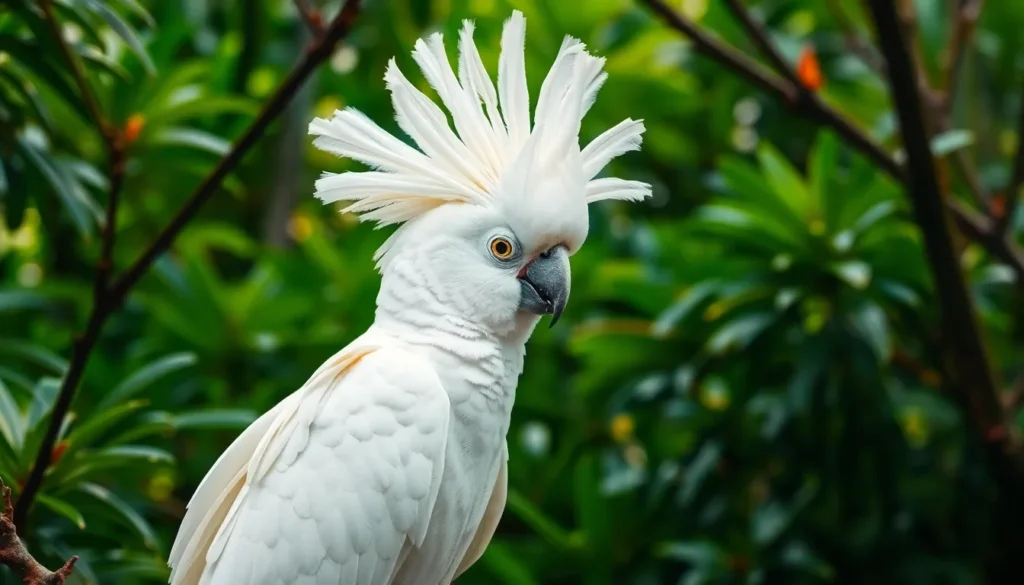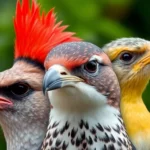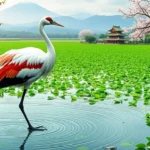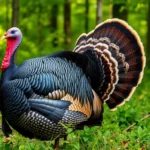White parrots captivate bird enthusiasts worldwide with their stunning snow-white plumage and remarkable intelligence. These extraordinary birds aren’t just beautiful—they’re among the most sought-after companions in the avian industry, combining striking appearance with incredible social abilities that make them unforgettable pets.
We’ve discovered that white parrots cover several fascinating species, from the majestic Umbrella Cockatoos to the playful White-capped Pionus. Each variety brings unique characteristics and care requirements that can transform your understanding of what makes these birds so special. Their pristine white feathers often serve as nature’s canvas, sometimes revealing subtle hints of color that add to their mystique.
Whether you’re considering adding a white parrot to your family or simply curious about these magnificent creatures, understanding their needs and behaviors is crucial. We’ll explore everything from their natural habitats to the exact care they require, helping you appreciate why white parrots continue to enchant bird lovers across the globe.
What Is a White Parrot Bird?
White parrot birds represent a diverse group of avian species characterized by predominantly white plumage and exceptional intelligence. These magnificent creatures belong to the Psittacidae family and showcase stunning pale coloration that sets them apart from their more colorful relatives.
Several distinct species exhibit white feathering patterns, including the Umbrella Cockatoo, Moluccan Cockatoo, and Lesser Sulphur-crested Cockatoo. Each species displays unique white variations ranging from pure snow-white to cream-colored tones with subtle yellow or pink accents on their crests and underwings.
The white coloration in these birds serves multiple evolutionary purposes beyond aesthetic appeal. Pale feathers help reflect sunlight in their native tropical habitats, providing natural temperature regulation during hot weather conditions. This adaptation proves particularly beneficial for species originating from Australia, Indonesia, and surrounding Pacific regions.
Physical characteristics extend beyond their striking white appearance to include powerful curved beaks designed for cracking nuts and seeds. Most white parrot species measure between 12 to 24 inches in length, with cockatoos representing the larger specimens in this category. Their distinctive head crests can be raised or lowered depending on their emotional state, creating an expressive communication tool.
Intelligence levels in white parrots rank among the highest in the avian industry, with cognitive abilities comparable to young children. These birds demonstrate problem-solving skills, vocal mimicry capabilities, and complex social behaviors that make them fascinating companions. Their ability to learn human speech patterns and understand contextual meanings distinguishes them from many other pet bird species.
Longevity represents another remarkable aspect of white parrot ownership, as these birds commonly live 40 to 80 years in captivity when provided with proper care. This extended lifespan creates a multigenerational commitment for families considering white parrot adoption.
Popular White Parrot Bird Species
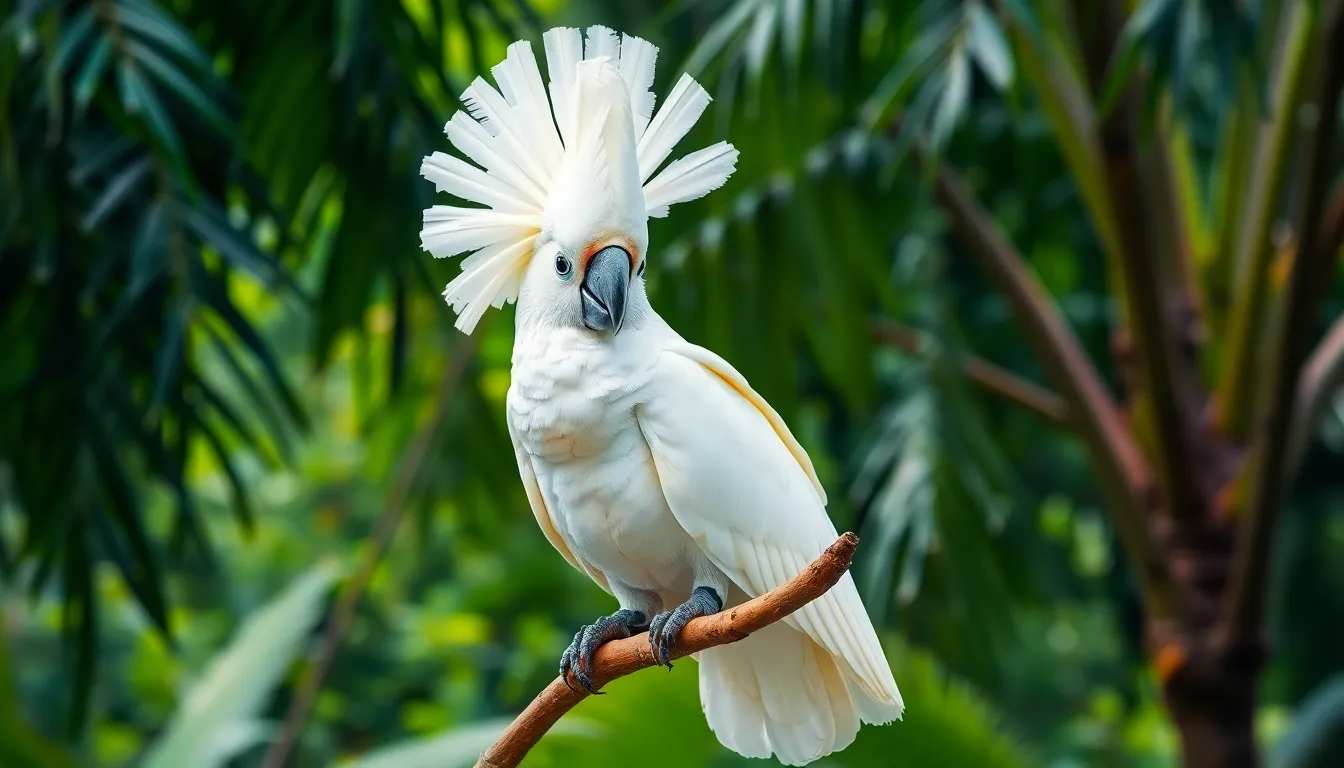
White parrot bird species captivate enthusiasts with their striking appearance and remarkable intelligence. These magnificent birds represent some of the most sought after companions in the avian industry.
Cockatoos
Cockatoos dominate the white parrot bird category with their impressive crests and captivating personalities. Umbrella Cockatoos (Cacatua alba) showcase pure white plumage with distinctive umbrella-shaped crests that expand when excited or threatened. These Indonesian natives reach 18 inches in length and demonstrate exceptional bonding capabilities with their human families.
Moluccan Cockatoos (Cacatua moluccensis) display salmon-pink undertones beneath their white feathers and possess the largest crests among cockatoo species. These birds measure up to 20 inches and originate from the Moluccas Islands, where they inhabit tropical rainforests.
Lesser Sulphur-crested Cockatoos (Cacatua sulphurea) feature bright yellow crests contrasting their white bodies and adapt well to captive environments. These medium-sized parrots reach 13 inches in length and exhibit playful behaviors that make them popular family pets.
Bare-eyed Cockatoos (Cacatua sanguinea) present blue eye rings surrounding their dark eyes and maintain smaller sizes compared to their relatives. These Australian natives measure 14 inches and demonstrate remarkable problem-solving abilities in both wild and domestic settings.
Albino and Leucistic Parrots
Albino white parrot birds result from genetic mutations that eliminate melanin production completely, creating pure white appearances with pink or red eyes. These rare specimens occur across multiple parrot species including African Greys, Cockatiels, and Budgerigars through recessive genetic traits.
Leucistic parrots retain partial pigmentation while displaying predominantly white feathering patterns throughout their bodies. These birds maintain normal eye coloration unlike their albino counterparts and often show subtle color variations in wing tips or tail feathers.
Lutino mutations produce yellow and white combinations in species like Cockatiels and Lovebirds, where red eyes accompany the light coloration. These genetic variations occur naturally in wild populations but appear more frequently in captive breeding programs.
Pied mutations create white patches mixed with normal coloring, resulting in unique patterns that vary significantly between individual birds. These partial white parrot bird variations maintain full health and vitality while displaying striking visual appeal.
White Bellied Caique
White Bellied Caiques (Pionites leucogaster) showcase brilliant white undersides contrasting their colorful backs and wings in vibrant displays. These energetic South American natives measure 9 inches in length and inhabit Amazon rainforest regions across Brazil, Peru, and Bolivia.
Physical characteristics include bright orange heads, green wings, and distinctive white belly patches that extend from throat to vent area. These compact parrots possess strong beaks adapted for crushing seeds and nuts while their zygodactyl feet excel at manipulation tasks.
Behavioral traits reveal highly social personalities that thrive on interaction and mental stimulation throughout daily activities. White Bellied Caiques demonstrate acrobatic abilities and playful nature that entertains families while requiring consistent engagement to prevent behavioral issues.
Habitat preferences cover lowland tropical forests where these white parrot birds form flocks of 30 or more individuals during feeding periods. They consume fruits, seeds, flowers, and occasional insects while contributing to forest network health through seed dispersal activities.
Physical Characteristics and Appearance
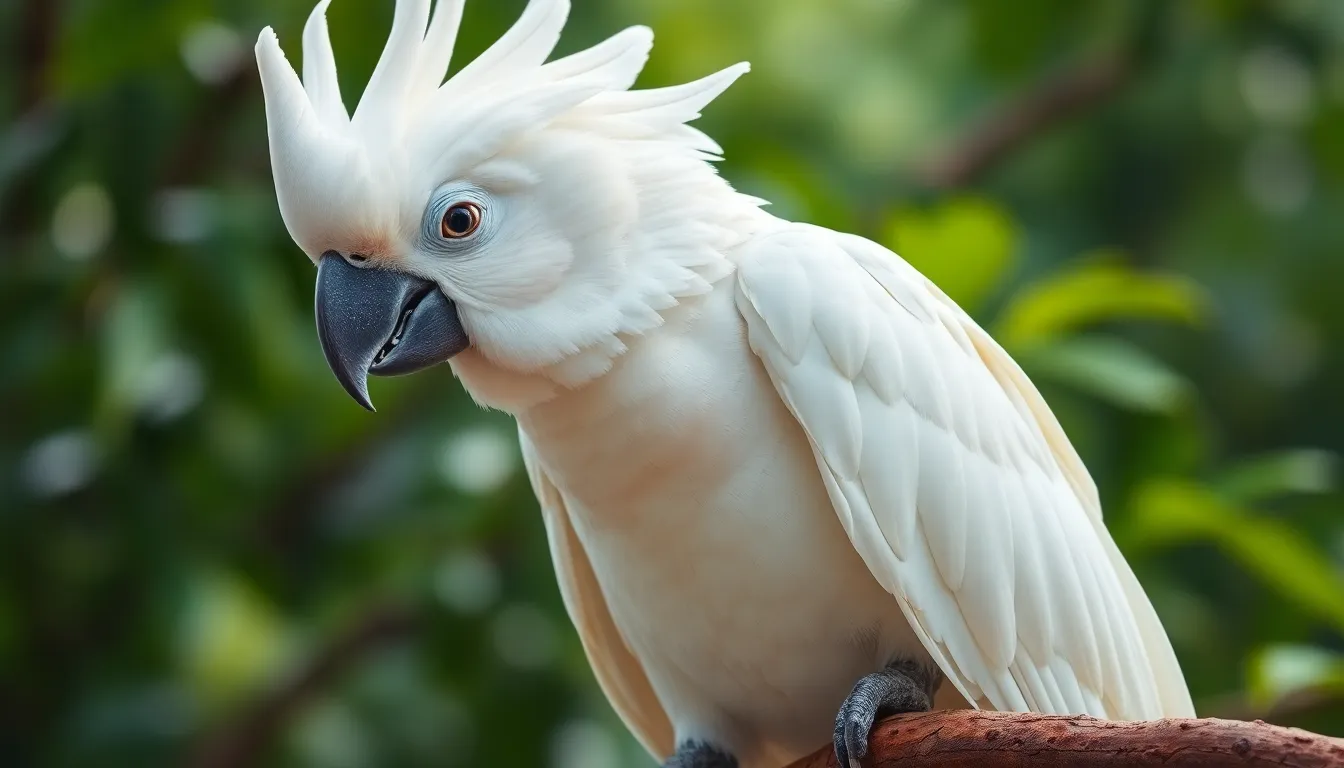
White parrot birds showcase remarkable physical diversity across species while maintaining their signature pale plumage. Most white parrots measure between 12 to 24 inches in length, with cockatoo species generally reaching the larger end of this spectrum. Their wingspan typically ranges from 18 to 36 inches, providing excellent flight capabilities in their natural habitats.
Distinctive plumage patterns differentiate white parrot species through subtle variations in their feather coloration. Umbrella Cockatoos display pure white feathers with yellow undertones on wing and tail tips. Moluccan Cockatoos feature salmon-pink patches beneath their wings and tail feathers. Lesser Sulphur-crested Cockatoos exhibit bright yellow crests and ear patches against their predominantly white bodies.
Powerful curved beaks serve as the most recognizable feature across all white parrot species. These beaks measure 1.5 to 3 inches in length and possess incredible strength for cracking nuts and seeds. The upper mandible curves downward over the lower mandible, creating an efficient tool for manipulating food and objects.
Expressive head crests communicate emotional states through various positions and movements. Cockatoos raise their crests when excited, curious, or alarmed, creating dramatic displays up to 6 inches tall. Relaxed birds keep their crests flat against their heads, while partially raised crests indicate moderate interest or attention.
| Physical Feature | Measurement Range | Notable Characteristics |
|---|---|---|
| Body Length | 12-24 inches | Varies by species |
| Wingspan | 18-36 inches | Enables strong flight |
| Beak Length | 1.5-3 inches | Curved and powerful |
| Crest Height | 3-6 inches | Highly expressive |
| Weight | 8-32 ounces | Species dependent |
Zygodactyl feet provide exceptional gripping ability with two toes facing forward and two backward. These feet function like hands, allowing white parrots to manipulate food, toys, and climbing surfaces with remarkable dexterity. Strong talons measure 0.5 to 1 inch in length and maintain sharp points through regular use.
Eye coloration varies significantly among white parrot species and changes with age. Young birds typically display dark brown or black eyes that lighten to amber, orange, or bright yellow as they mature. Some species like Bare-eyed Cockatoos develop distinctive blue eye rings that contrast beautifully with their white facial feathers.
Feather structure consists of multiple layers providing insulation and waterproofing capabilities. Powder down feathers create a fine dust that helps maintain plumage condition and provides natural waterproofing. These specialized feathers continuously shed microscopic particles that coat other feathers with protective powder.
Personality and Temperament Traits
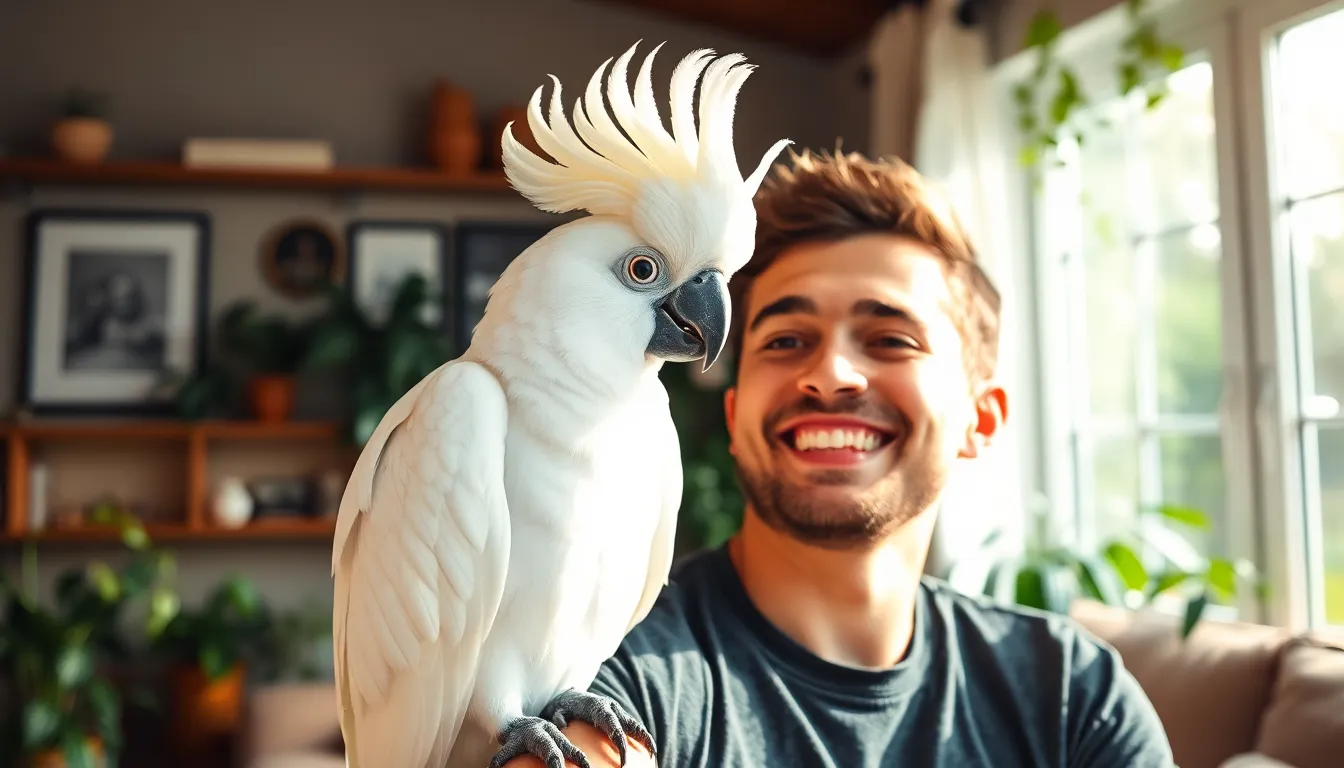
White parrot birds exhibit remarkably complex personalities that combine intelligence with strong emotional needs. These magnificent creatures demonstrate affectionate behaviors toward their human companions, often forming deep bonds that last decades. Social interaction remains essential for their psychological wellbeing, as isolation can lead to destructive behaviors like feather plucking or excessive screaming.
Cockatoo species display particularly expressive temperaments through their dramatic crest movements and vocalizations. Umbrella Cockatoos show playful yet demanding personalities that require consistent attention and mental stimulation throughout the day. Moluccan Cockatoos possess gentle dispositions but can become possessive of their favorite family members, displaying jealousy toward other pets or household members.
Behavioral Characteristics of White Parrots:
| Trait | Description | Intensity Level |
|---|---|---|
| Affection Level | Strong bonding with owners | High |
| Vocalization | Mimicry and natural calls | Moderate to High |
| Social Needs | Requires daily interaction | Very High |
| Intelligence | Problem-solving abilities | Exceptional |
| Playfulness | Active engagement with toys | High |
Communication patterns among white parrots include sophisticated vocal mimicry capabilities that extend beyond simple word repetition. Lesser Sulphur-crested Cockatoos often develop extensive vocabularies while maintaining their natural flock call behaviors. White-capped Pionus birds demonstrate quieter temperaments compared to larger cockatoo species, making them suitable for apartment living environments.
Territorial behaviors manifest differently across white parrot species, with some showing protective instincts over their cages or favorite perching areas. Bare-eyed Cockatoos typically exhibit more independent personalities while still craving regular human interaction. Emotional sensitivity runs high in these birds, as they respond strongly to changes in household routines or family dynamics.
Training responsiveness varies among individual white parrots, though most species demonstrate excellent learning capabilities when provided with positive reinforcement methods. White Bellied Caiques display energetic personalities that require extensive physical activity and mental challenges to prevent boredom-related behaviors. Consistency in handling and training produces the best behavioral outcomes for all white parrot species.
Care Requirements for White Parrot Birds
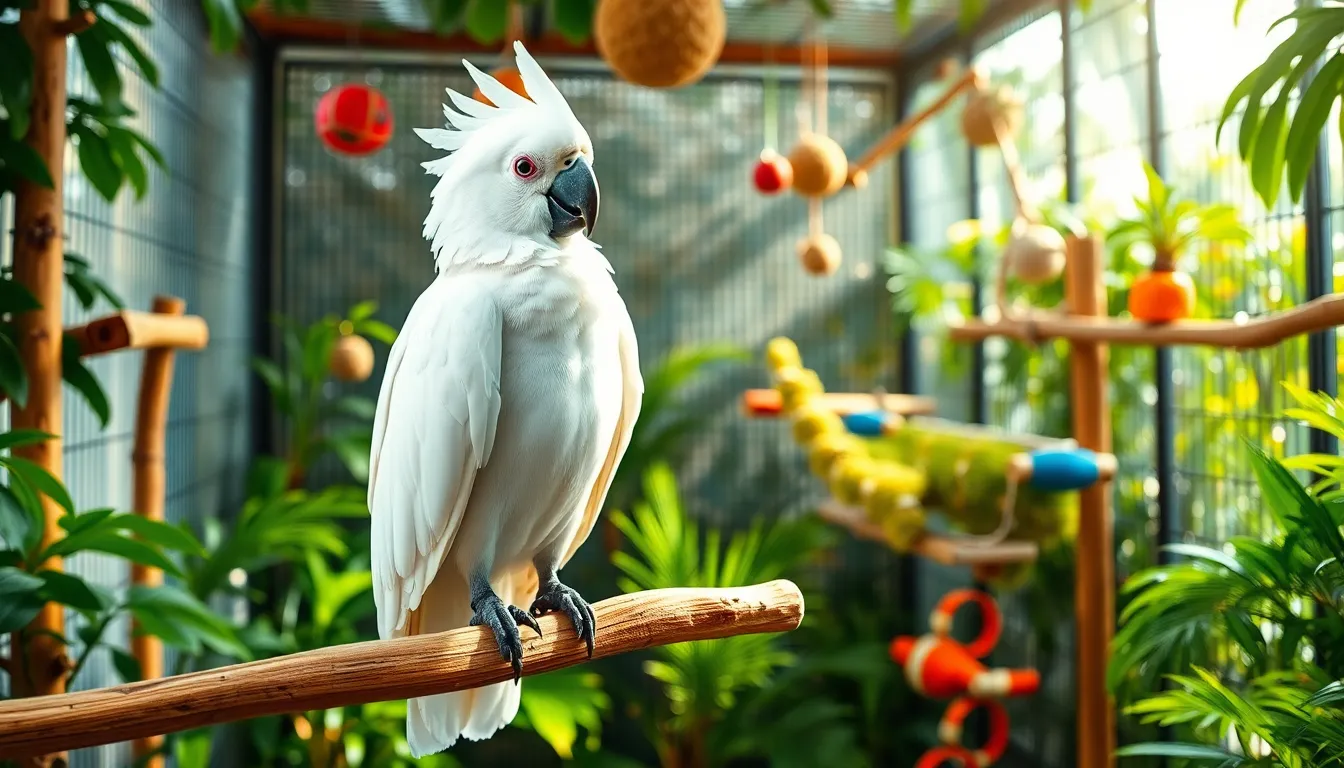
White parrot birds demand comprehensive care that addresses their complex physical and emotional needs. These intelligent companions thrive when we provide proper housing, balanced nutrition, and captivating activities that challenge their remarkable cognitive abilities.
Housing and Environment
White parrots require spacious enclosures that accommodate their large wingspan and active nature. Cages must measure at least 40 inches wide, 30 inches deep, and 60 inches tall for medium-sized species like Umbrella Cockatoos, while larger Moluccan Cockatoos need enclosures measuring 48 inches in width and 72 inches in height. Bar spacing ranges from 0.75 to 1 inch for most white parrot species to prevent escape and injury.
Temperature control maintains optimal health for these tropical birds, with ideal ranges between 65-80°F throughout the day. Humidity levels stay between 50-60% to support healthy feather development and respiratory function. Natural sunlight exposure for 10-12 hours daily regulates circadian rhythms, though full-spectrum UV lighting serves as an acceptable alternative during winter months.
Perch variety prevents foot problems common in captive parrots, incorporating natural wood branches, rope perches, and mineral perches of different diameters. We place perches at varying heights to encourage climbing and exercise. Safe wood options include apple, willow, and birch branches that we replace regularly to maintain cleanliness.
Environmental enrichment transforms basic housing into stimulating living spaces. Foraging toys, puzzle feeders, and rotating toy collections keep white parrots mentally engaged. We position food and water dishes away from perching areas to maintain hygiene and encourage natural foraging behaviors.
Diet and Nutrition
White parrots consume diverse diets that mirror their natural feeding patterns in tropical environments. High-quality pellets form the foundation, comprising 60-70% of daily food intake for optimal nutritional balance. Pellet brands like Harrison’s, Zupreem, and Roudybush provide species-appropriate formulations for large parrots.
Fresh vegetables contribute 20-25% of daily nutrition, with dark leafy greens, orange vegetables, and cruciferous options providing essential vitamins. Acceptable vegetables include kale, sweet potatoes, broccoli, carrots, and bell peppers served chopped or grated for easy consumption. We introduce new vegetables gradually to prevent digestive upset.
Fruits serve as healthy treats, representing 5-10% of total diet volume. Safe fruit choices include apples, berries, grapes, and tropical fruits like papaya and mango. Seeds and nuts provide healthy fats but require portion control, with 1-2 tablespoons daily preventing excessive weight gain.
Toxic foods pose serious health risks and require complete avoidance. Chocolate, avocado, caffeine, alcohol, and foods high in salt or sugar can cause severe illness or death. Fruit pits, apple seeds, and onions also present dangers to white parrot health.
Fresh water changes occur daily using filtered or bottled water to eliminate chlorine and contaminants. Stainless steel or ceramic bowls resist bacterial growth better than plastic alternatives. We monitor water consumption as changes often indicate health issues requiring veterinary attention.
Exercise and Mental Stimulation
White parrots demand 3-4 hours of supervised out-of-cage time daily to maintain physical fitness and mental health. Flight exercise strengthens wing muscles and cardiovascular systems when safe indoor spaces allow supervised flying. Wing clipping prevents flight but requires careful consideration of each bird’s individual needs and safety circumstances.
Climbing opportunities satisfy natural behaviors and provide excellent exercise through rope gyms, play stands, and bird-safe trees. We create climbing challenges using natural branches and safe materials that encourage exploration and physical activity. Play gyms measuring 4-6 feet in height accommodate large white parrots comfortably.
Mental stimulation prevents destructive behaviors common in intelligent species through puzzle toys, foraging activities, and training sessions. Rotating toy collections every 2-3 weeks maintains novelty and interest. Foraging opportunities hide treats inside paper cups, cardboard tubes, and specialized foraging toys that encourage natural feeding behaviors.
Interactive training sessions lasting 10-15 minutes twice daily build strong human-parrot bonds while providing mental challenges. Target training, step-up commands, and trick learning engage cognitive abilities and create positive interactions. We use positive reinforcement techniques with healthy treats and praise to encourage desired behaviors.
Social interaction requirements vary by species but typically demand 4-6 hours of human companionship daily. Umbrella Cockatoos require constant social engagement, while Lesser Sulphur-crested Cockatoos tolerate brief periods alone. We establish consistent daily routines that include feeding, training, play, and quiet time to reduce stress and behavioral problems.
Health Considerations and Common Issues
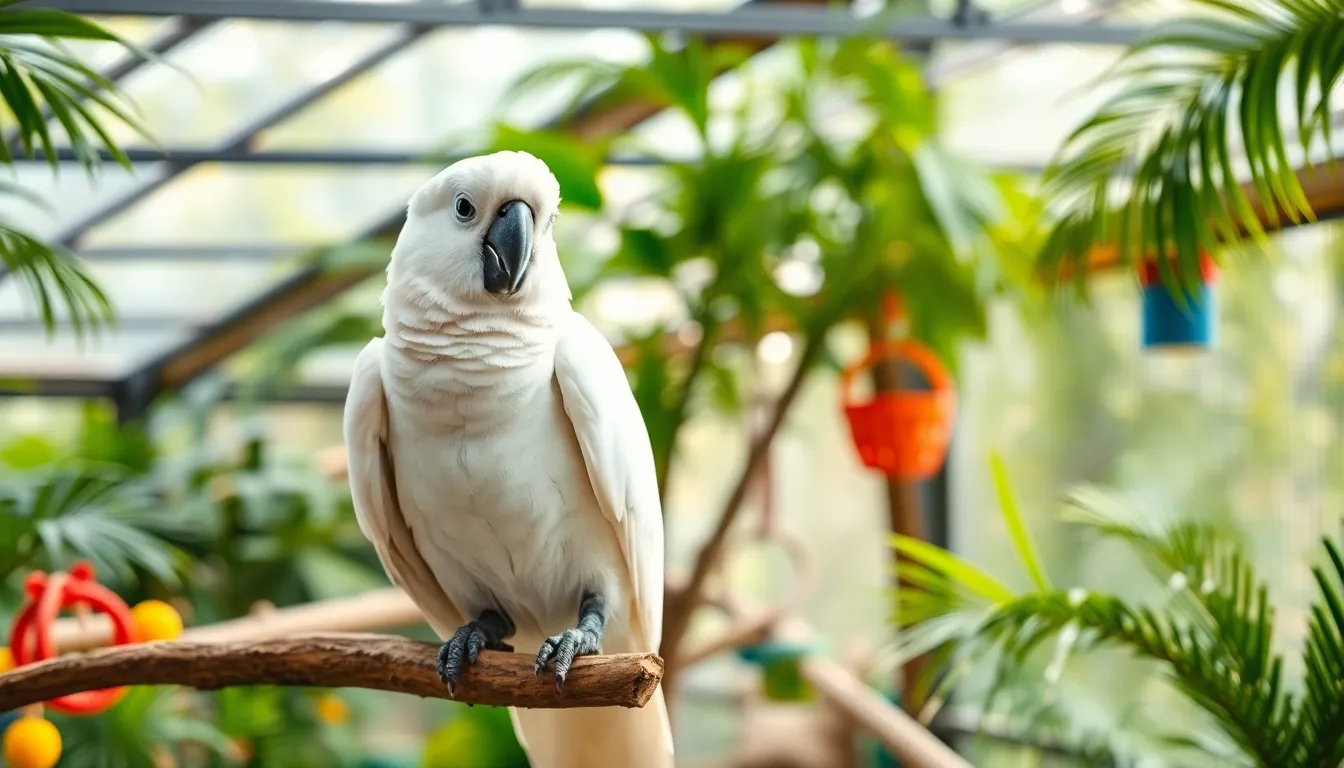
White parrot birds face several health challenges that require our attention and proactive care. Understanding these potential issues helps us maintain our feathered companions’ wellbeing throughout their extended lifespans.
Common Respiratory Problems
Respiratory infections rank among the most frequent health concerns affecting white parrots. Psittacosis (parrot fever) affects cockatoos particularly often, spreading through airborne particles and causing symptoms like lethargy, discharge from eyes or nostrils, and difficulty breathing. Air quality directly impacts respiratory health, making proper ventilation essential in living spaces.
Aspergillosis presents another important threat, especially in environments with poor air circulation. This fungal infection targets the respiratory system and proves challenging to treat once established. Symptoms include tail bobbing, open-mouth breathing, and voice changes that alert us to potential problems.
Feather and Skin Conditions
Feather destructive behavior affects many white parrots, particularly cockatoos experiencing stress or boredom. This self-mutilating behavior manifests as excessive preening, plucking, or chewing feathers until bare patches appear. Environmental enrichment and consistent social interaction reduce these behaviors significantly.
Psittacine Beak and Feather Disease (PBFD) specifically targets the immune system, causing feather abnormalities and beak deformities. Umbrella Cockatoos and other white species show particular vulnerability to this viral infection. Testing enables early detection, though no cure currently exists.
| Health Issue | Primary Symptoms | Prevention Method |
|---|---|---|
| Respiratory infections | Nasal discharge, breathing difficulty | Maintain air quality, regular vet checkups |
| Feather plucking | Bare patches, damaged feathers | Provide enrichment, reduce stress |
| PBFD | Abnormal feather growth, beak issues | Quarantine new birds, regular testing |
| Nutritional deficiencies | Dull plumage, lethargy | Balanced diet, vitamin supplements |
Nutritional Health Issues
Vitamin A deficiency commonly affects white parrots fed seed-only diets, leading to respiratory infections and poor feather quality. Converting birds to pellet-based diets supplemented with fresh vegetables prevents these deficiencies effectively.
Iron storage disease impacts certain species, including some cockatoo varieties. This condition results from excessive iron absorption, causing liver damage over time. Low-iron diets help manage this hereditary condition.
Behavioral Health Concerns
Separation anxiety frequently develops in bonded white parrots, creating destructive behaviors when left alone. Gradual independence training and environmental enrichment help reduce anxiety levels. Establishing consistent routines provides security and reduces stress-related health problems.
Hormonal aggression peaks during breeding seasons, affecting both males and females differently. Limiting daylight exposure to 10-12 hours and removing nesting materials helps control hormonal surges naturally.
Preventive Health Measures
Regular veterinary examinations every 6-12 months catch health issues before they become severe. Annual blood work monitors organ function and detects early signs of disease. Quarantining new birds for 30-45 days prevents disease transmission to existing flock members.
Weight monitoring provides early indicators of health changes, as rapid weight loss often signals illness. Digital scales accurate to 1-gram increments help track subtle changes that might otherwise go unnoticed.
Environmental factors play crucial roles in maintaining health. Temperature ranges between 65-80°F (18-27°C) with humidity levels around 50-60% create optimal conditions for white parrots. Sudden temperature changes stress birds and compromise their immune systems.
Training and Socialization Tips
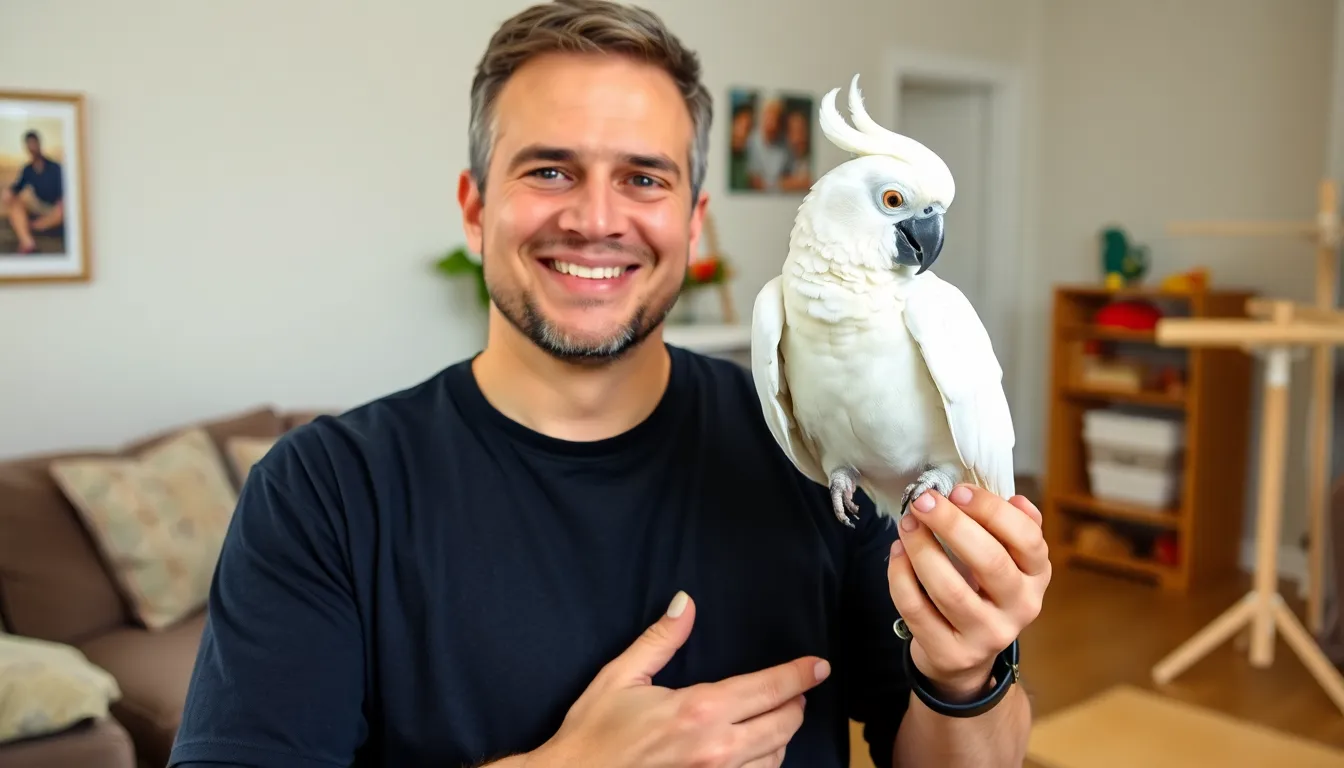
Training white parrots requires consistency and patience since these intelligent birds respond best to positive reinforcement techniques. Start training sessions when your cockatoo or other white parrot species is calm and focused, typically in the morning after they’ve eaten. Use small healthy treats like sunflower seeds or pieces of apple to reward desired behaviors immediately after they occur.
Establishing Basic Commands
Teaching basic commands forms the foundation of effective white parrot training. Begin with simple words like “step up” when placing your finger near their feet and “step down” when moving them to their perch. Practice these commands 3-4 times daily during 10-15 minute sessions to prevent overwhelming your bird. Most Umbrella Cockatoos and Moluccan Cockatoos master basic commands within 2-3 weeks of consistent practice.
Addressing Behavioral Challenges
Cockatoos and other white parrots often develop attention-seeking behaviors like excessive screaming or feather plucking when their social needs aren’t met. Ignore negative behaviors completely while immediately rewarding quiet, calm behavior with attention and treats. Create a consistent daily routine that includes structured interaction time to reduce anxiety-driven behaviors. Environmental enrichment through puzzle toys and foraging activities helps redirect destructive tendencies into positive mental stimulation.
Socialization Strategies
Proper socialization prevents white parrots from becoming overly bonded to one family member. Encourage multiple household members to interact with your bird daily through feeding, training, and playtime activities. Expose your cockatoo to different people, sounds, and environments gradually to build confidence and reduce fear responses. Start socialization during the first few months of ownership when birds are most adaptable to new experiences.
Building Trust and Communication
White parrots communicate through body language, vocalizations, and crest positioning that owners must learn to interpret correctly. A raised crest on cockatoos typically indicates excitement or alertness, while flattened feathers against their body suggests fear or illness. Respond to your bird’s communication cues by adjusting your approach and respecting their comfort zones. Regular gentle handling during calm moments builds trust and makes necessary procedures like nail trimming less stressful for both you and your parrot.
Cost of Owning a White Parrot Bird
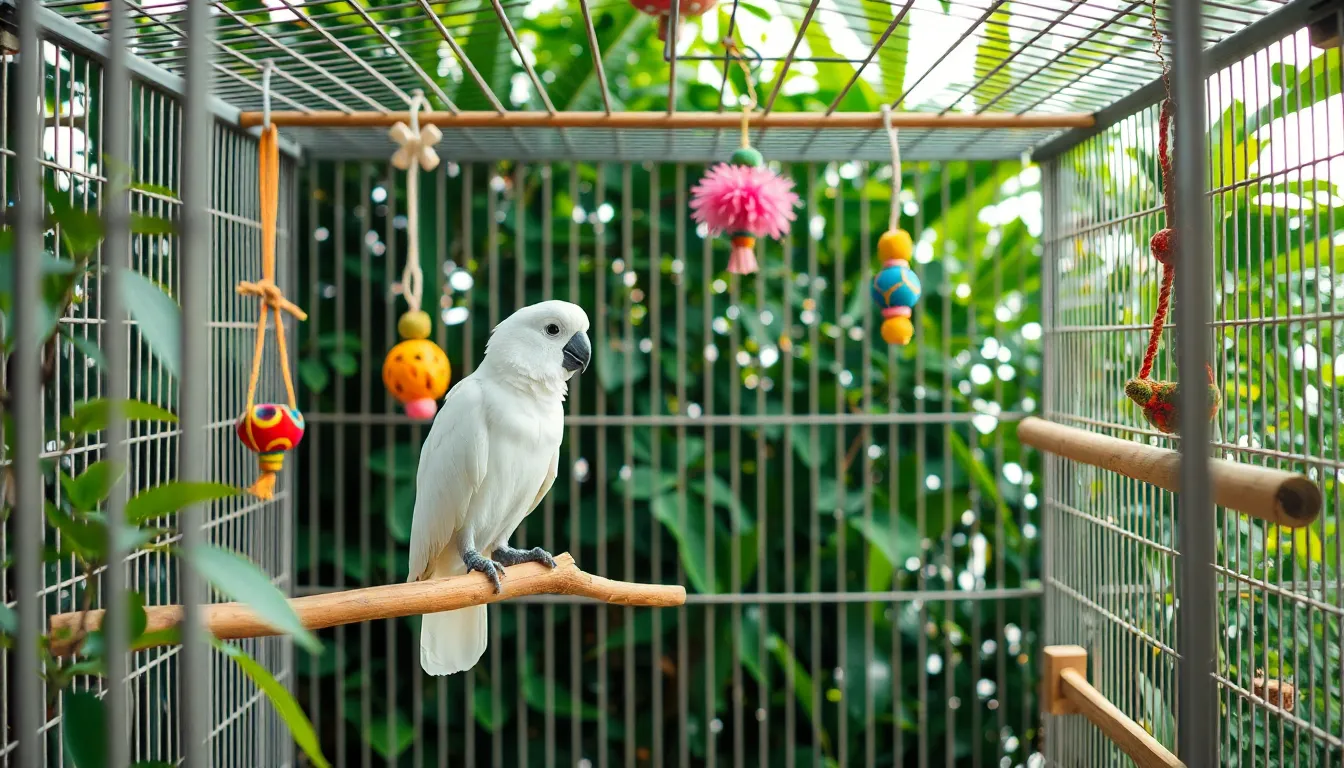
Owning a white parrot bird represents a important financial commitment spanning several decades of expenses. The initial purchase price varies dramatically based on species and breeder reputation.
Initial Purchase Costs
| Species | Price Range | Breeder Reputation Impact |
|---|---|---|
| Umbrella Cockatoo | $1,500 – $4,000 | Premium breeders add 30-50% |
| Moluccan Cockatoo | $2,000 – $5,000 | Hand-fed birds cost more |
| Lesser Sulphur-crested Cockatoo | $800 – $2,500 | Show quality birds premium |
| White-capped Pionus | $600 – $1,200 | Rare mutations increase cost |
| White Bellied Caique | $1,200 – $2,800 | Breeding pairs cost double |
Reputable breeders charge higher prices but provide health guarantees and proper socialization. Rescue organizations offer adoption fees ranging from $200 to $800 depending on the bird’s age and rehabilitation needs.
Essential Equipment and Setup
Setting up a proper environment for white parrots requires substantial upfront investment in quality equipment.
Large Enclosures: Appropriate cages cost $800 to $2,500 for cockatoos, with powder-coated steel construction being the most durable option. Smaller species like White-capped Pionus require cages costing $400 to $1,000.
Perching Systems: Natural wood perches from apple, willow, and birch trees cost $50 to $150 per setup. Rope perches and mineral perches add another $30 to $80 to the total investment.
Feeding Equipment: Stainless steel food bowls, water dispensers, and foraging toys total $100 to $300 for a complete feeding station.
Environmental Controls: Air purifiers designed for bird environments cost $200 to $500, while full-spectrum lighting systems range from $150 to $400.
Monthly Recurring Expenses
White parrot ownership involves consistent monthly costs that accumulate significantly over their 40 to 80-year lifespans.
Premium Nutrition: High-quality pellet diets cost $25 to $60 monthly depending on bird size. Fresh organic vegetables and safe fruits add $40 to $80 monthly to grocery expenses. Specialized treats and foraging materials contribute another $15 to $30 monthly.
Toy Replacement: Intelligent white parrots destroy toys quickly, requiring $30 to $100 monthly replacements to maintain mental stimulation. Wooden toys last 1 to 3 weeks, while rope toys need replacement every 2 to 4 weeks.
Cleaning Supplies: Bird-safe disinfectants, cage liners, and specialized cleaning products cost $20 to $40 monthly for proper hygiene maintenance.
Veterinary Care Costs
Preventive and emergency veterinary care represents one of the largest ongoing expenses for white parrot owners.
Regular Checkups: Annual wellness examinations with avian veterinarians cost $150 to $300 per visit. Semi-annual visits become necessary for birds over 15 years old, doubling these expenses.
Diagnostic Testing: Blood panels, fecal examinations, and crop cultures range from $200 to $500 annually for healthy birds. X-rays and specialized imaging add $300 to $800 when medical issues arise.
Emergency Treatment: Common respiratory infections cost $400 to $1,200 to treat properly. Feather plucking behavioral therapy sessions range from $100 to $250 per consultation.
Specialized Procedures: Beak and nail trimming by professionals costs $50 to $100 every 6 to 8 weeks. Wing clipping services range from $25 to $75 depending on regional pricing.
Long-Term Financial Planning
The extended lifespan of white parrots creates unique financial planning challenges that distinguish them from other pet ownership experiences.
Lifetime Cost Projections: Umbrella Cockatoos living 60 years accumulate $60,000 to $120,000 in total ownership costs. Smaller species like White Bellied Caiques cost $35,000 to $70,000 over their 30-year lifespans.
Insurance Considerations: Exotic pet insurance policies covering white parrots cost $30 to $80 monthly with deductibles ranging from $250 to $500. Coverage limitations often exclude pre-existing conditions and behavioral treatments.
Estate Planning: Many white parrot owners establish trust funds or care arrangements since these birds often outlive their original owners. Professional bird boarding during vacations costs $25 to $60 daily, adding important travel-related expenses.
Is a White Parrot Bird Right for You?
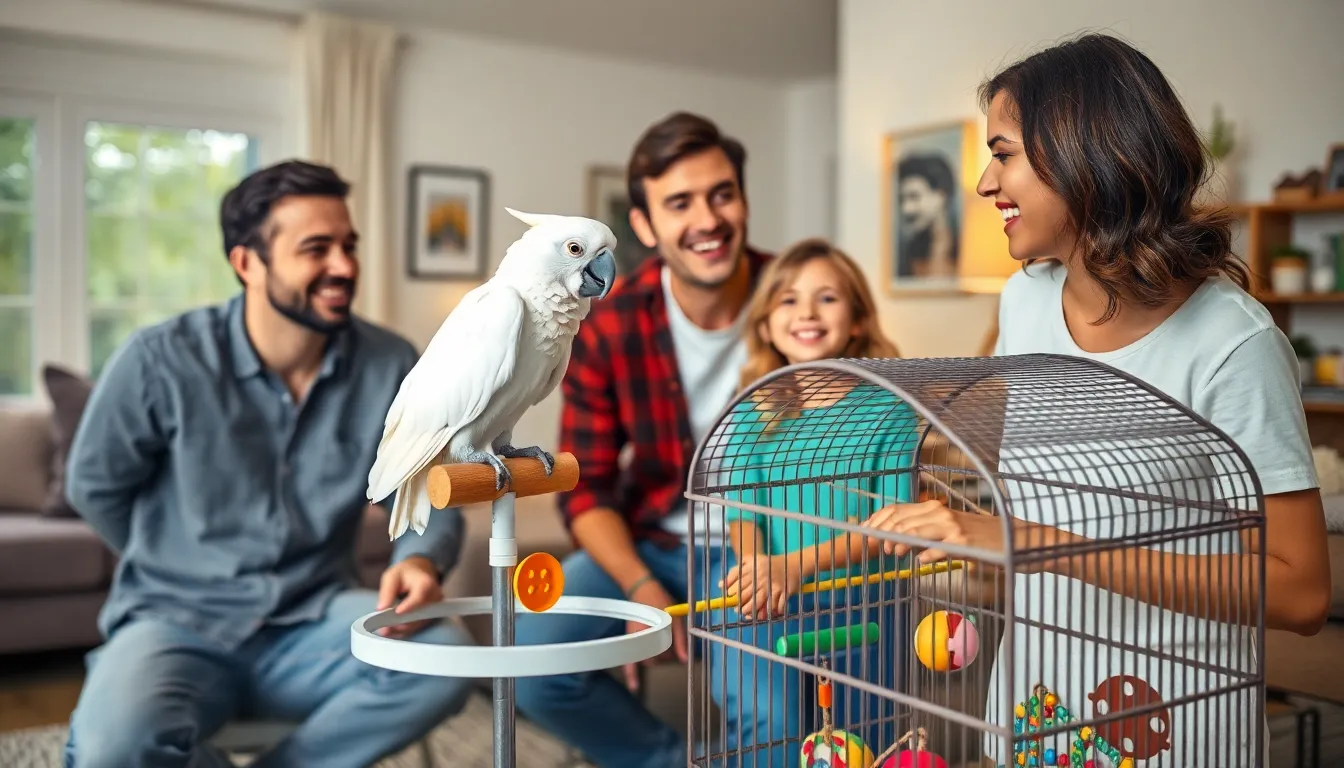
Evaluating your lifestyle compatibility with white parrot birds requires honest assessment of your living situation, time availability, and long-term commitment capacity. White parrot species demand 3-4 hours of daily interaction outside their enclosures if you’re prepared to provide consistent socialization and mental stimulation.
Lifestyle Compatibility Assessment
Your household dynamics determine white parrot bird ownership success since these intelligent creatures thrive in stable environments with predictable routines. Families with young children must consider noise tolerance levels as cockatoos produce vocalizations reaching 135 decibels during morning and evening activity periods.
Living Space Requirements:
- Apartment dwellers face challenges with noise restrictions and limited flight space
- Homeowners can accommodate larger enclosures measuring 4x4x6 feet minimum for Umbrella Cockatoos
- Rental properties may restrict exotic bird ownership through lease agreements
Working professionals spending 8+ hours away daily create unsuitable environments for white parrot birds since these social creatures develop separation anxiety and destructive behaviors without adequate interaction.
Time and Energy Demands
Daily care routines for white parrot birds consume 4-6 hours when factoring feeding schedules, cleaning requirements, and supervised exercise periods. Morning preparation involves fresh food preparation, water changes, and cage maintenance taking approximately 45 minutes.
Weekly Time Commitments:
- Training sessions: 30-45 minutes daily for behavioral reinforcement
- Cage deep cleaning: 2-3 hours for thorough sanitization
- Veterinary appointments: Monthly health checks averaging 1-2 hours
- Social enrichment: Interactive play sessions requiring constant supervision
We observe that owners underestimating these time demands frequently experience behavioral issues including feather plucking, excessive screaming, and aggressive tendencies in their white parrot birds.
Financial Readiness Evaluation
Long-term financial planning becomes essential since white parrot birds live 40-80 years and require consistent veterinary care, premium nutrition, and environmental enrichment throughout their extended lifespans.
| Cost Category | Initial Investment | Monthly Expenses |
|---|---|---|
| Bird Purchase | $1,500-$15,000 | – |
| Enclosure Setup | $800-$2,500 | – |
| Premium Pellets | – | $40-$60 |
| Fresh Produce | – | $25-$40 |
| Veterinary Care | – | $50-$150 |
| Toy Replacement | – | $30-$50 |
Emergency veterinary expenses ranging from $500-$3,000 occur when white parrot birds develop respiratory infections, nutritional deficiencies, or behavioral health concerns requiring immediate professional intervention.
Experience Level Considerations
First-time bird owners encounter important challenges with white parrot species since these intelligent creatures require specialized knowledge of avian behavior, nutrition, and environmental management. Experienced parrot enthusiasts possess foundational skills including reading body language cues, implementing positive reinforcement training, and recognizing early illness symptoms.
Beginner-Friendly Alternatives:
- Cockatiels offer similar intelligence with reduced care complexity
- Conures provide social interaction without extreme noise levels
- Budgerigars deliver companionship with minimal space requirements
Advanced bird keepers successfully manage multiple white parrot birds through established routines, proper socialization techniques, and comprehensive understanding of species-exact behavioral patterns.
Long-Term Commitment Reality
White parrot bird ownership represents a multi-generational responsibility since these creatures often outlive their original caregivers, requiring estate planning considerations and potential rehoming arrangements. Your family members must understand care protocols and demonstrate willingness to assume responsibilities during emergencies or extended absences.
Commitment Factors:
- Career changes affecting daily schedules and interaction time
- Relocation requirements involving transport logistics and housing adjustments
- Health considerations limiting physical ability to maintain large enclosures
- Family expansion introducing new household members and routine disruptions
Successful white parrot bird owners maintain consistent dedication through life transitions while prioritizing their birds’ emotional and physical wellbeing above convenience factors.
Conclusion
White parrots represent some of the most remarkable companions in the avian industry. Their striking beauty intelligence and complex personalities make them extraordinary pets for those ready to embrace the commitment.
We’ve explored how these magnificent birds require dedicated care consistent training and substantial financial investment throughout their decades-long lifespans. Success with white parrots depends entirely on matching their needs with your lifestyle and capabilities.
Before welcoming one of these feathered family members we encourage thorough self-assessment of your readiness. Consider your living situation time availability and long-term commitment carefully.
With proper preparation and dedication white parrots can bring immense joy and companionship to the right households for many years to come.
Frequently Asked Questions
What are white parrots and what makes them special?
White parrots are intelligent birds from the Psittacidae family, characterized by predominantly white plumage. They’re special because of their exceptional intelligence, ability to mimic speech, problem-solving skills, and expressive personalities. Their white coloration serves evolutionary purposes like temperature regulation in tropical habitats. These birds can live 40-80 years and form deep emotional bonds with their human companions.
What are the most popular white parrot species?
The most popular white parrot species include Umbrella Cockatoos, Moluccan Cockatoos, Lesser Sulphur-crested Cockatoos, and Bare-eyed Cockatoos. Each has distinct features and personalities. White Bellied Caiques are also popular for their vibrant appearance and social nature. Additionally, genetic variations like albino, leucistic, lutino, and pied mutations create unique color patterns in various parrot species.
What kind of personality do white parrots have?
White parrots have complex personalities combining high intelligence with strong emotional needs. They’re highly affectionate, social, and vocal birds that form deep bonds with their human companions. Cockatoos can be playful yet demanding, while some species may show possessive tendencies. They require daily social interaction to prevent destructive behaviors and thrive on mental stimulation and consistent routines.
What are the care requirements for white parrots?
White parrots need spacious enclosures with proper temperature and humidity control, varied perches, and 3-4 hours of supervised out-of-cage time daily. Their diet should consist of high-quality pellets, fresh vegetables, and safe fruits. They require mental stimulation through interactive toys, training sessions, and social interaction. Consistent routines help reduce stress and behavioral issues.
What health issues do white parrots commonly face?
Common health issues include respiratory infections, feather and skin conditions, and nutritional deficiencies. Specific diseases like Psittacosis and Aspergillosis can affect them. Behavioral health concerns include separation anxiety and hormonal aggression. Preventive measures include regular veterinary checkups, maintaining good air quality, proper nutrition, and monitoring environmental conditions to ensure optimal health.
How much does it cost to own a white parrot?
Initial costs vary by species and breeder reputation, plus essential equipment and setup expenses. Monthly recurring costs include premium nutrition, toy replacements, and veterinary care. Due to their 40-80 year lifespans, long-term financial planning is crucial. Owners should also consider insurance and estate planning, as these birds often outlive their original caregivers.
Are white parrots good pets for beginners?
White parrots require significant experience and aren’t typically recommended for beginners. They need daily interaction, spacious living areas, and substantial time and energy commitments. The financial investment is considerable, and their long lifespans require extensive planning. Beginner-friendly alternatives might be better for those new to bird keeping. Success requires understanding their complex behavioral and emotional needs.
How long do white parrots live?
White parrots have exceptionally long lifespans, typically living 40-80 years in captivity with proper care. This longevity makes them a significant long-term commitment that often spans multiple decades. Their extended lifespans require owners to consider estate planning and the ability to adapt to life changes while maintaining the birds’ well-being throughout their lives.

